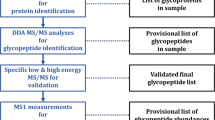Abstract
Alterations inN- andO-linked glycosylation affect cell surface expression and antigenicity of recombinant glycophorin A expressed in transfected Chinese hamster ovary (CHO) cells. To understand these effects further, glycophorin A was purified by immunoaffinity chromatography from transfected wild type and glycosylation deficient CHO cells. TheO-glycans were characterized both biochemically, using gel filtration and high performance anion exchange chromatography, and immunologically, using carbohydrate specific monoclonal antibodies to probe Western blots. TheO-glycans of human erythrocyte glycophorin A consist mainly of short oligosaccharides with one, two, or three sialic acid residues linked to a common disaccharide core, Galβ1-3GalNAcα1-Ser/Thr, with the disialylated structure being the most abundant. With the exception of the trisialylated derivative, the same structures were found on recombinant glycophorin A expressed by wild type CHO cells. However, in contrast to human crythrocyte glycophorin A, the monosialylated oligosaccharide was the most abundant structure on the recombinant protein. Furthermore, recombinant glycophorin A was shown to express a small amount of the Tn antigen (GalNAcα1-Ser/Thr). Recombinant glycophorin A had the sameO-glycan composition, whether purified from clones expressing high or moderate levels of the recombinant glycoprotein. This indicates that the level of expression of the transfected glycoprotein did not affect itsO-glycan composition. Deletion of theN-linked glycosylation site at Asn26, by introducing the Mi.I mutation (Thr28 → Met) by site-directed mutagenesis, did not markedly affect theO-glycan composition of the resulting recombinant glycoprotein expressed in wild type CHO cells. This demonstrates that the presence or absence of theN-glycan did not influenceO-linked glycosylation of the recombinant glycoprotein. Finally, theO-glycans on recombinant glycophorin A expressed in the Lec 2 and Lec 8 glycosylation deficient CHO cells were characterized. TheO-glycans on Lec 2 cell glycophorin A were predominantly Galβ1-3GalNAcα1-Ser/Thr (T antigen), while those on Lec 8 glycophorin A were exclusively GalNAcα1-Ser/Thr (Tn antigen). These results will lead to a better understanding of the cell biology and immunology of this important human erythrocyte glycoprotein.
Similar content being viewed by others
References
Tomita M, Marchesi VT (1975)Proc Natl Acad Sci USA 72:2954–68.
Fukuda M, Lauffenburger M, Sasaki H, Rogers ME, Dell A (1987)J Biol Chem 262:11952–57.
Yoshima H, Furthmayr H, Kobata A (1980)J Biol Chem 255:9713–18.
Thomas DB, Winzler RJ (1969)J Biol Chem 244:5943–46.
Blumenfeld OO, Adamany AM (1978)Proc Natl Acad Sci USA 75:2727–31.
Lisowska E, Wasniowska K (1978)Eur J Biochem 88:247–52.
Dahr W (1992)Vox Sang 62:129–35.
Telischi M, Behzad O, Issitt PD, Pavone BG (1976)Vox Sang 31:109–16.
Rearden A, Frandson S, Carry JB (1987)Vox Sang 52:318–21.
Holliman SM (1989) InBlood Group Systems: MN and Gerbich, 1st edition (Unger PJ, Laird-Fryer, eds) pp. 1–29. Arlington, VA: American Association of Blood Banks.
Silberstein LE, Goldman J, Kant JA, Spitalnik SL (1988)Arch Biochem Biophys 264:244–52.
Kim YD (1980)Vox Sang 39:162–68.
Hadley TJ, Klotz FW, Miller LH (1986)Ann Rev Microbiol 40:451–77.
Remaley AT, Ugorski M, Wu N, Litzky L, Burger SR, Moore JS, Fukuda M, Spitalnik SL (1991)J Biol Chem 266:24176–83.
Ugorski M, Blackall DP, Påhlsson P, Shakin-Eshleman SH, Moore J, Spitalnik SL (1993)Blood 82:1913–20.
Blackall DP, Ugorski M, Påhlsson P, Shakin-Eshleman SH, Spitalnik SL (1993)J Immunol (in press).
Blackall DP, Ugorski M, Smith ME, Påhlsson P, Spitalnik SL (1992)Transfusion 32:629–32.
Nichols ME, Rosenfeld RD, Rubinstein P (1985)Vox Sang 49:138–48.
Telen MJ, Scearce RM, Haynes BF (1987)Vox Sang 52:236–43.
Gardner B, Parsons SF, Merry AH, Anstee DJ (1989)Immunology 68:283–89.
Wasniowska K, Duk M, Steuden I, Czerwinski M, Wiedlocha A, Lisowska E. (1988)Arch Immunol Ther Exp 36:623–32.
Rubocki R, Milgrom F (1986)Vox Sang 51:217–25.
Bigbee WL, Vanderlaan M, Fong SSN, Jensen RH (1983)Mol Immunol 20:1353–62.
Bigbee WL, Langlois RG, Vanderlaan M, Jensen RH (1984)J Immunol 133:3149–55.
Jaskiewicz E, Lisowska E, Lundblad A (1990)Glycoconjugate J 7:255–68.
Jaskiewicz E, Moulds JJ, Kraemer K, Goldstein AS, Lisowska E (1990)Transfusion 30:230–35.
Lisowska E, Messeter L, Duk M, Czerwinski M, Lundblad A (1987)Mol Immunol 24:605–13.
Duk M, Steuden I, Dus D, Radzikowski C, Lisowska E (1992)Glyeoconjugate J 9:148–53.
Judd WJ, Issitt PD, Pavone BG, Anderson J, Aminoff D (1979)Transfusion 19:12–18.
King JM, Parsons SF, Wu AM, Jones N (1991)Transfusion 31:142–49.
Perkins ME, Holt EH (1988)Mol Biochem Parasitol 27:23–34.
Dahr W, Newman RA, Contreras M, Kordowicz M, Teesdale P, Beyreuther K, Kruger J (1984)Eur J Biochem 138:259–65.
Stanley P, Caillibot V, Siminovich L (1975)Cell 6:121–28.
Stanley P (1984)Ann Rev Genet 18:525–52.
Deutscher SL, Nuwayhid N, Stanley P, Barak-Briles EI, Hirschberg CB (1984)Cell 39:295–99.
Deutscher SL, Hirschberg CB (1986)J Biol Chem 261:96–100.
Ho SN, Hunt HD, Horton RM, Pullen JK, Pease LR (1989)Gene 77:51–59.
Laemmli UK (1970)Nature 227:680–85.
Blumenfeld OO, Zvilichovsky B (1972)Methods Enzymol 28:245–52.
Carlson DM (1968)J Biol Chem 243:616–26.
Fukuda M (1989)Methods Enzymol 179:17–29.
Krotkiewski H, Nilsson B, Svensson S (1989)Eur J Biochem 184:29–38.
Townsend RR, Hardy MR, Lee YC (1989)Methods Enzymol 179:65–76.
Varki A, Diaz S (1984)Anal Biochem 137:236–47.
Angel AS, Lindh F, Nilsson B (1987)Carbohydr Res 168:15–31.
Distler JJ, Jourdian GW (1978)Methods Enzymol 50:514–20.
Påhlsson P, Shakin-Eshleman SH, Spitalnik SL (1992)Biochem Biophys Res Commun 189:1667–73.
Duk M, Czerwinski M, Lisowska E (1992)Hybridoma 11:181–90.
Cummings RD, Kornfeld S, Schneider WJ, Hobgood KK, Tolleshaug H, Brown MS, Goldstein JL (1983)J Biol Chem 258:15261–73.
Kobata A, Yamashita K, Takasaki S (1987)Methods Enzymol 138:84–94.
Towbin H, Staehelin T, Gordon J (1979)Proc Natl Acad Sci USA 76:4350–54.
Steuden I, Duk M, Czerwinski M, Radzikowski C, Lisowska E (1985)Glycoconjugate J 2:303–14.
Hirohashi S, Clausen H, Yamada T, Shimosato Y, Hakomori S (1985)Proc Natl Acad Sci USA 82:7039–43.
Varki A (1991)FASEB J 5:226–35.
Kornfeld R, Kornfeld S (1985)Ann Rev Biochem 54:631–64.
Johnson DC, Spear PG (1983)Cell 32:987–97.
Abeijon C, Hirschberg CB (1987)J Biol Chem 262:4153–59.
Pascale MC, Erra MC, Malagolini N, Serafini-Cessi F, Leone A, Bonatti S (1992)J Biol Chem 267:25196–201.
Duk M, Sticher U, Brossmer R, Lisowska E (1994)Glycobiology (in press).
Author information
Authors and Affiliations
Rights and permissions
About this article
Cite this article
Påhlsson, P., Blackall, D.P., Ugorski, M. et al. Biochemical characterization of theO-glycans on recombinant glycophorin A expressed in Chinese hamster ovary cells. Glycoconjugate J 11, 43–50 (1994). https://doi.org/10.1007/BF00732431
Received:
Issue Date:
DOI: https://doi.org/10.1007/BF00732431



